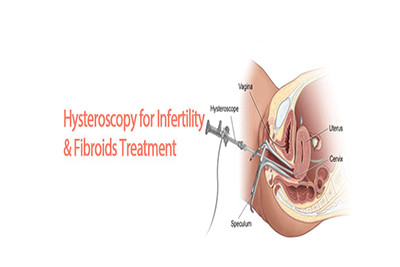Why Do I Need Hysteroscopy In IVF?
Why Do I Need Hysteroscopy In IVF?

Hysteroscopy is the inspection of the uterine cavity by endoscopy with access through the cervix. It allows for the diagnosis of intrauterine pathology (diagnostic hysteroscopy) and serves as a method for surgical intervention (operative hysteroscopy).
A hysteroscope which is an endoscope that carries optical and light channels or fibers is introduced in a sheath that provides an inflow and outflow channel for distension of the uterine cavity. In addition, an operative channel may be present to introduce scissors, graspers or biopsy instruments.
Why Do I Need Hysteroscopy In IVF?
- To diagnose and treat Asherman’s Syndrome i.e. adhesion bands inside the uterine cavity where baby implants.
- To diagnose and treat submucous fibroid or endometrial polyps found in the uterine cavity.
- To dilate the cervix in cases of cervical stenosis.
- Removal of embedded IUD
- To correct septum dividing the uterine canal.
How Is Procedure Done?
Prior to the procedure, your doctor may prescribe a sedative to help you relax. You will then be prepared for anesthesia. The procedure itself takes place in the following order:
- The doctor will dilate (widen) your cervix to allow the hysteroscope to be inserted.
- The hysteroscope is inserted through your vagina and cervix into the uterus.
- Carbon dioxide gas or a liquid solution is then inserted into the uterus, through the hysteroscope, to expand it and to clear away any blood or mucus.
- Next, a light shone through the hysteroscope allows your doctor to see your uterus and the openings of the fallopian tubes into the uterine cavity.
- Finally, if surgery needs to be performed, small instruments are inserted into the uterus through the hysteroscope.
The time it takes to perform hysteroscopy can range from less than 5 minutes to more than an hour. The length of the procedure depends on whether it is diagnostic or operative and whether an additional procedure, such as laparoscopy, is done at the same time. In general, however, diagnostic hysteroscopy takes less time than operative.
How Do I Feel Following The Procedure?
Some women will experience cramping similar to period pains after a hysteroscopy, but this usually passes after a few days.
Most women feel they can return to normal activities, such as work, the day after the procedure.
How Do I Prepare The Procedure?
It is best to have a hysteroscopy done when you are not having your menstrual period but menses is no contraindication. If there is a chance that you could become pregnant, the hysteroscopy should be done before you are ovulating so your doctor is sure you are not pregnant. Do not douche, use tampons, or use vaginal medicines for 24 hours before the hysteroscopy.
What Are The Risks Involved?
A hysteroscopy is a very safe procedure, with a low risk of complications.
The two most commonly reported complications of a hysteroscopy are:
- accidental damage to the womb or cervix, which may require further treatment to correct – this occurs in around 1 in 135 cases
- excessive bleeding during or after surgery, which happens in around 1 in 400 cases
In almost all cases, the benefits of having a hysteroscopy far outweigh the potential risks.





